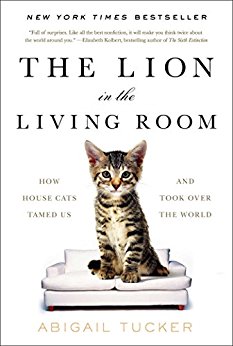Cats are among our closest animal companions. There are about 100 million cats in the U.S., a number that continues to grow. Yet there is a distinct downside in this relationship. Some consider them an environmental disaster; our feline friends kill an estimated 1.4 to 3.7 billion birds each year, and they’ve been blamed for many mammalian extinctions. They’ve become so numerous that millions of stray cats are euthanized each year. And reportedly almost half of house cats have physically attacked their owners. So how did we get pulled into this long-term relationship?
There is now a fascinating book entitled The Lion in the Living Room: How Cats Tamed Us and Took Over the World by Abigail Tucker. In it, she traces cats’ journey from predator to intruder, explores the similarities between cats and lions, and explains why we’ve come to put up with them. She claims cats are uniquely unsuited to domestication. The first animals we picked to tame could  be kept in confined spaces and were happy to eat almost anything, like pigs and goats. We also favored animals like dogs and cattle that had social hierarchies we could dominate. But cats have none of these qualities.
be kept in confined spaces and were happy to eat almost anything, like pigs and goats. We also favored animals like dogs and cattle that had social hierarchies we could dominate. But cats have none of these qualities.
So how did they become domesticated? It was probably the cats’ idea. About 10,000 years ago, we started making environmental changes, like building settlements. Animals like badgers, foxes, and small wildcats began infiltrating to eat our trash. In other words, we created an environmental niche, and animals began exploiting it.
But we didn’t make pets of badgers and foxes. That’s probably because in appearance, cats have a huge advantage. Quite simply, they have physical features that remind us of human babies. For example, they have small noses and big round eyes in the middle of round faces. All of this is accidental — they don’t need big noses because they don’t hunt by smell — but these features suggest our own infants. So we’re much more likely to bond with a cat than a raccoon.
The implications are quite extensive, so to learn more, there is an excellent interview with Abigail Tucker at http://nymag.com/scienceofus/2016/12/how-cats-became-domesticated.html? . It’s entitled (no kidding!) ” Humans and Cats Have a Strange, Complicated History”. The book is available on Amazon.com at https://www.amazon.com/dp/B01CO34KU6/ref=dp-kindle-redirect?_encoding=UTF8&btkr=1&tag=sciofus-20 .
